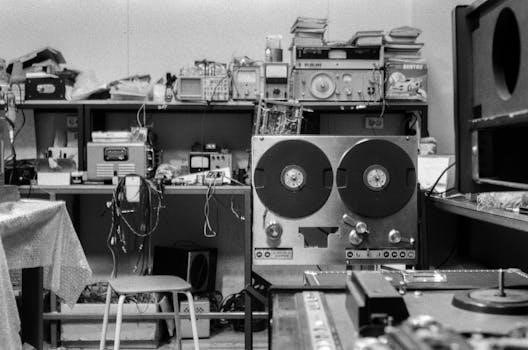M-Audio Keystation 49 MK3 Manual Overview
This section provides a general overview of the M-Audio Keystation 49 MK3 manual. It covers the content, availability, and purpose of the guide for users. The manual is crucial for proper setup and functionality.
The M-Audio Keystation 49 MK3 is a 49-key USB MIDI keyboard controller designed for music production and performance. It is a versatile tool for musicians, producers, and songwriters. This keyboard offers a semi-weighted key action, providing a responsive feel suitable for various playing styles. The Keystation 49 MK3 is powered via USB, simplifying setup and making it portable. It features assignable controls, pitch and modulation wheels, enhancing creative possibilities. It also includes software such as MPC Beats and Ableton Live Lite for immediate music creation. This controller is compatible with both Windows and Mac operating systems. Its user-friendly design makes it accessible for both beginners and experienced users. The Keystation 49 MK3 is a dependable MIDI keyboard for any studio or live setup.
Key Features and Specifications
The M-Audio Keystation 49 MK3 boasts several key features. It includes 49 synth-action keys, providing a comfortable playing experience. The keyboard uses the standard MIDI protocol for seamless connection to computers. It offers assignable controls, allowing customization of your workflow. Pitch and modulation wheels add expressive capabilities to your performances. The device is powered via USB, eliminating the need for an external power source. It comes with bundled software, including MPC Beats and Ableton Live Lite. This keyboard is compatible with both Windows and Mac operating systems. The Keystation 49 MK3 has a USB 2.0 connection. It has a compact design for easy integration into various setups. The device features a sustain pedal input for expanded playing options. The M-Audio Keystation 49 MK3 is designed for ease of use and versatility.

Manual Availability and Languages
This section outlines where to find the M-Audio Keystation 49 MK3 user manual. It also specifies the languages in which the manual is available for download and viewing by users.
Where to Find the User Manual
The user manual for the M-Audio Keystation 49 MK3 is readily available online for convenient access. You can find it on the official M-Audio website, typically within the support or downloads section associated with the product. Many online databases that host user manuals also provide access to the Keystation 49 MK3 manual. These platforms often offer free PDF downloads, allowing you to save the manual for offline use. Additionally, websites that specialize in musical instrument manuals may feature the Keystation 49 MK3 manual. Checking these sources ensures you have the most current and accurate guide for your device. Be sure to register your product on the m-audio website to access manual and other resources. Some retailers or online marketplaces that sell the Keystation 49 MK3 might also provide a link to the manual on their product page.
Available Languages of the Manual
The M-Audio Keystation 49 MK3 user manual is primarily available in English, ensuring a broad audience can easily understand the instructions and features. This is the most common language for technical manuals in the music industry. However, to cater to a global user base, the manual is sometimes provided in other languages. These may include Spanish, French, and Italian. The availability of these different languages can vary depending on the region and the specific source from where you access the manual. Often, the manual is translated into other languages to ensure users around the world can easily use the device. It’s always advisable to check the official M-Audio website for the most current list of supported languages for the Keystation 49 MK3 manual. Some online platforms may host manuals in additional languages too, so checking several sources may provide more options.

Software and Setup
This section details the bundled software with the Keystation 49 MK3, including MPC Beats and Ableton Live Lite. It further describes the necessary steps for connecting and setting up with a computer.
Included Software⁚ MPC Beats and Ableton Live Lite
The M-Audio Keystation 49 MK3 comes bundled with two powerful software packages designed to get you creating music right away⁚ MPC Beats and Ableton Live Lite. MPC Beats offers a comprehensive platform for beat-making, featuring a vast library of sounds and samples, along with intuitive sequencing tools. This software allows users to quickly develop grooves and full tracks with ease. On the other hand, Ableton Live Lite is a renowned digital audio workstation (DAW) known for its flexible workflow and session view, ideal for both live performance and studio production. This DAW lets you record, arrange, and mix your musical ideas effectively. Both software options provide a great starting point for beginners and a solid foundation for more experienced music producers. Registration of your Keystation 49 MK3 on the m-audio website is required to access these included software downloads.
Connecting and Setting up with Computer
To connect the M-Audio Keystation 49 MK3 to your computer, use the provided standard USB cable. Ensure the USB cable is securely plugged into both the keyboard and your computer’s USB port. For best performance, it is recommended to connect directly to a USB port on your computer, rather than using a USB hub. If a USB hub is necessary, ensure it is a powered hub to provide sufficient power to the keyboard. Once connected, your computer should recognize the Keystation 49 MK3 as a MIDI device. You may need to select the Keystation as your MIDI input device within your chosen Digital Audio Workstation (DAW) software, such as MPC Beats or Ableton Live Lite. The device may appear as ‘USB Audio Device’ on Windows 8 or as ‘Keystation 49 MK3’ on other operating systems. Following the user manual will aid in completing the setup process effectively.

Technical Specifications and Controls
This section outlines the technical details of the M-Audio Keystation 49 MK3. It includes information about the number of keys, control types, power source, and MIDI protocol used by the device.
Number of Keys and MIDI Protocol
The M-Audio Keystation 49 MK3 features 49 velocity-sensitive keys, which provide a responsive and expressive playing experience for musicians. These keys allow for a wide range of musical expression, catering to different playing styles. The keyboard adheres to the standard MIDI protocol, ensuring seamless communication with various digital audio workstations (DAWs) and virtual instruments. This universal compatibility makes the Keystation 49 MK3 a versatile tool for music production. The MIDI protocol enables the keyboard to transmit note data, velocity information, and control change messages to connected devices. This data then is interpreted by the software to produce sound or control other parameters, allowing for a powerful and flexible workflow. The use of the MIDI protocol also facilitates integration with a wide array of music software and hardware, expanding its usability.
Control Types and Power Source
The M-Audio Keystation 49 MK3 incorporates several control types, enhancing its functionality. It features assignable buttons, allowing users to customize controls for specific DAW functions. Pitch bend and modulation wheels provide expressive real-time manipulation of sound. These controls offer hands-on adjustments for a more dynamic performance. The keyboard is powered via USB, eliminating the need for an external power adapter. This USB power source simplifies setup and allows for convenient use with computers. The power source also makes the keyboard portable and easy to use in different locations. The USB connectivity allows both power and MIDI data transmission through a single cable. This reduces cable clutter and makes the setup process more streamlined and simple for users.

Troubleshooting and Additional Information
This section addresses common problems users might encounter. It also provides guidance on accessing support and additional resources for further assistance with the M-Audio Keystation 49 MK3.
Common Issues and Solutions
Many users occasionally face issues with their M-Audio Keystation 49 MK3. One frequent problem involves the keyboard not being recognized by the computer. This can often be resolved by ensuring the USB connection is secure, trying a different USB port, or using a powered USB hub. Another common issue is the keyboard not triggering notes in the DAW (Digital Audio Workstation). Confirm that the Keystation 49 MK3 is selected as the MIDI input device in your DAW’s preferences. Also, verify that the appropriate MIDI channel is selected. If the included software isn’t working, make sure that you have properly registered the device on the m-audio website, and that you are following the installation instructions in your user account. Some users have reported that the keys don’t respond as expected; this may be resolved through adjusting the velocity curve settings in the DAW or reconfiguring the device settings in the software. Regularly check for software and driver updates, as outdated software can cause connectivity and performance issues.
Accessing Support and Further Assistance
If you encounter issues that the manual cannot resolve, M-Audio provides various avenues for support. The official M-Audio website has a dedicated support section, offering FAQs, knowledge base articles, and driver downloads. You can also find user forums where other Keystation 49 MK3 owners share solutions and experiences. If you still need additional help, the website has contact information to reach the technical support team by email or phone. M-Audio also offers support through their social media channels where users ask questions and engage with the company. Remember to register your product on m-audio.com to access software downloads and technical support. Be sure to provide the product serial number when requesting support. Always check the website for the most current information and manuals. You can also search online for user groups or forums, as other users have often had similar problems and can provide advice.

